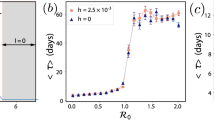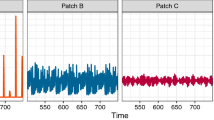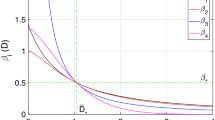Abstract
A central question in population ecology is the role of ‘exogenous’ environmental factors versus density-dependent ‘endogenous’ biological factors in driving changes in population numbers1. This question is also central to infectious disease epidemiology, where changes in disease incidence due to behavioural or environmental change must be distinguished from the nonlinear dynamics of the parasite population2. Repeated epidemics of primary and secondary syphilis infection in the United States over the past 50 yr have previously been attributed to social and behavioural changes3. Here, we show that these epidemics represent a rare example of unforced, endogenous oscillations in disease incidence, with an 8–11-yr period that is predicted by the natural dynamics of syphilis infection, to which there is partially protective immunity4. This conclusion is supported by the absence of oscillations in gonorrhoea cases, where a protective immune response is absent5,6. We further demonstrate increased synchrony of syphilis oscillations across cities over time, providing empirical evidence for an increasingly connected sexual network in the United States.
This is a preview of subscription content, access via your institution
Access options
Subscribe to this journal
Receive 51 print issues and online access
$199.00 per year
only $3.90 per issue
Buy this article
- Purchase on Springer Link
- Instant access to full article PDF
Prices may be subject to local taxes which are calculated during checkout



Similar content being viewed by others
References
Bjornstad, O. N. & Grenfell, B. T. Noisy clockwork: Time series analysis of population fluctuations in animals. Science 293, 638–643 (2001)
Pascual, M., Rodo, X., Ellner, S. P., Colwell, R. & Bouma, M. J. Cholera dynamics and el Nino-Southern Oscillation. Science 289, 1766–1769 (2000)
Nakashima, A. K., Rolfs, R. T., Flock, M. L., Kilmarx, P. & Greenspan, J. R. Epidemiology of syphilis in the United States, 1941–1993. Sex. Transm. Dis. 23, 16–23 (1996)
Morgan, C. A., Lukehart, S. A. & Van Voorhis, W. C. Protection against syphilis correlates with specificity of antibodies to the variable regions of Treponema pallidum repeat protein K. Infect. Immun. 71, 5605–5612 (2003)
Fox, K. K. et al. Longitudinal evaluation of serovar-specific immunity to Neisseria gonorrhoeae . Am. J. Epidemiol. 149, 353–358 (1999)
Schmidt, K. A. et al. Experimental gonococcal urethritis and reinfection with homologous gonococci in male volunteers. Sex. Transm. Dis. 28, 555–564 (2001)
Chatfield, C. The Analysis of Time Series: an Introduction 6th edn (Chapman & Hall/CRC, Boca Raton, 2003)
Grenfell, B. T., Bjornstad, O. N. & Kappey, J. Travelling waves and spatial hierarchies in measles epidemics. Nature 414, 716–723 (2001)
Hethcote, H. W. & Yorke, J. A. Gonorrhea Transmission Dynamics and Control in Lecture Notes Biomath no. 56 (Springer, Berlin, 1984)
Garnett, G. P., Aral, S. O., Hoyle, D. V., Cates, W. & Anderson, R. M. The natural history of syphilis: Implications for the transmission dynamics and control of infection. Sex. Transm. Dis. 24, 185–200 (1997)
Garnett, G. P., Mertz, K. J., Finelli, L., Levine, W. C. & St Louis, M. E. The transmission dynamics of gonorrhoea: modelling the reported behaviour of infected patients from Newark, New Jersey. Phil. Trans. R. Soc. Lond. B 354, 787–797 (1999)
Hook, E. W. et al. Delayed presentation to clinics for sexually transmitted diseases by symptomatic patients—A potential contributor to continuing STD morbidity. Sex. Transm. Dis. 24, 443–448 (1997)
Greenberg, J. B. et al. Learning from clients: An opportunity for sexually transmitted disease programs. J. Public Health Manage Pract. 8, 59–68 (2002)
Wasserheit, J. N. & Aral, S. O. The dynamic topology of sexually transmitted disease epidemics: implications for prevention strategies. J. Infect. Dis. 174(suppl. 2), S201–S213 (1996)
Hamers, F. F. et al. Syphilis and Gonorrhea in Miami—Similar clustering, different trends. Am. J. Public Health 85, 1104–1108 (1995)
Bailey, N. T. J. The Mathematical Theory of Infectious Diseases and its Applications 2nd edn (Griffin, London, 1975)
Lloyd, A. L. & May, R. M. Spatial heterogeneity in epidemic models. J. Theor. Biol. 179, 1–11 (1996)
U.S. Department of Transportation Bureau of Transportation Statistics. National Transportation Statistics 2003 (U.S. Government Printing Office, Washington DC, 2003)
Cliff, A. D., Haggett, P. & Smallman-Raynor, M. in Deciphering Global Epidemics: Analytical Approaches to the Disease Records of World Cities, 1888–1912 (eds Baker, A. R. H., Dennis, R. & Holdsworth, D.) (Cambridge Univ. Press, Cambridge, 1998)
Wallace, R., Huang, Y. S., Gould, P. & Wallace, D. The hierarchical diffusion of AIDS and violent crime among US metropolitan regions: Inner-city decay, stochastic resonance and reversal of the mortality transition. Soc. Sci. Med. 44, 935–947 (1997)
Keeling, M. J. & Rohani, P. Estimating spatial coupling in epidemiological systems: a mechanistic approach. Ecol. Lett. 5, 20–29 (2002)
Lloyd, A. L. & Jansen, V. A. A. Spatiotemporal dynamics of epidemics: synchrony in metapopulation models. Math. Biosci. 188, 1–16 (2004)
Aral, S. O. The social context of syphilis persistence in the southeastern United States. Sex. Transm. Dis. 23, 9–15 (1996)
Kuperman, M. & Abramson, G. Small world effect in an epidemiological model. Phys. Rev. Lett. 86, 2909–2912 (2001)
Chesson, H. W., Dee, T. S. & Aral, S. O. AIDS mortality may have contributed to the decline in syphilis rates in the United States in the 1990s. Sex. Transm. Dis. 30, 419–424 (2003)
Kahn, R. H., Heffelfinger, J. D. & Berman, S. M. Syphilis outbreaks among men who have sex with men—A public health trend of concern. Sex. Transm. Dis. 29, 285–287 (2002)
Wolitski, R. J., Valdiserri, R. O., Denning, P. H. & Levine, W. C. Are we headed for a resurgence of the HIV epidemic among men who have sex with men? Am. J. Public Health 91, 883–888 (2001)
Bjørnstad, O. N., Ims, R. A. & Lambin, X. Spatial population dynamics: analyzing patterns and processes of population synchrony. Trends Ecol. Evol. 14, 427–432 (1999)
Nåsell, I. Stochastic models of some endemic infections. Math. Biosci. 179, 1–19 (2002)
Gibson, C. Population of the 100 Largest Cities and Other Urban Places in the United States: 1790–1990 (Working Paper No. 27, Population Division, US Census Bureau, Washington DC, 1998)
Acknowledgements
The authors are grateful to M. Flock and S. Berman at the US Centers for Disease Control and Prevention for making available the disease case reports and for discussion on data quality. We also thank J. Truscott, J. Lewis, P. White, N. Ferguson, S. Riley and O. Bjørnstad for advice and help in analysis of periodic time-series data. N.C.G. and C.F. would like to thank the Royal Society, and G.P.G. and C.F. the Medical Research Council for funding.
Author information
Authors and Affiliations
Corresponding author
Ethics declarations
Competing interests
The authors declare that they have no competing financial interests.
Supplementary information
Supplementary Methods
Provides a more detailed description of the data, and the spectral and cross-correlation analyses used, together with additional details and results for the SIRS model. (DOC 90 kb)
Supplementary Table 1
Lists the possible transitions and associated rates for the SIRS model of infection. (DOC 29 kb)
Supplementary Figure 1
Comparison of the deterministic and stochastic SIRS model, demonstrating sustained oscillations in prevalence in the stochastic case, even when a significant fraction of individuals fail to develop protective immunity after infection. (PDF 49 kb)
Rights and permissions
About this article
Cite this article
Grassly, N., Fraser, C. & Garnett, G. Host immunity and synchronized epidemics of syphilis across the United States. Nature 433, 417–421 (2005). https://doi.org/10.1038/nature03072
Received:
Accepted:
Issue Date:
DOI: https://doi.org/10.1038/nature03072
This article is cited by
-
Recent advances in multifunctional shape memory photonic crystals and practical applications
Nano Research (2024)
-
Epidemic graph diagrams as analytics for epidemic control in the data-rich era
Nature Communications (2023)
-
Investigation of the immune escape mechanism of Treponema pallidum
Infection (2023)
-
Global phylogeny of Treponema pallidum lineages reveals recent expansion and spread of contemporary syphilis
Nature Microbiology (2021)
-
Mathematical Assessment of the Role of Early Latent Infections and Targeted Control Strategies on Syphilis Transmission Dynamics
Acta Biotheoretica (2019)
Comments
By submitting a comment you agree to abide by our Terms and Community Guidelines. If you find something abusive or that does not comply with our terms or guidelines please flag it as inappropriate.



